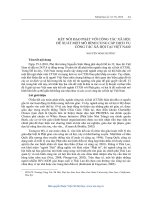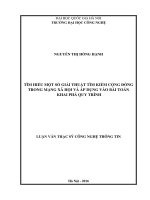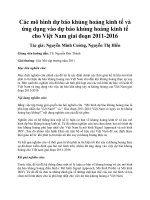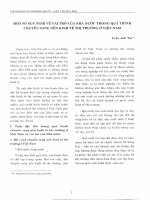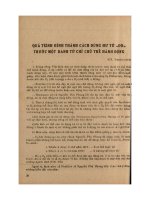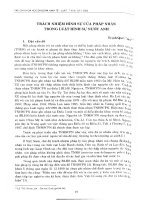DSpace at VNU: Một mô hình tìm kiếm vai trò trong mạng xã hội Twitter
Bạn đang xem bản rút gọn của tài liệu. Xem và tải ngay bản đầy đủ của tài liệu tại đây (181.33 KB, 4 trang )
Một mô hình tìm kiếm vai trò trong mạng xã hội
Twitter
Đinh Thị Hương
Trường đại học Công nghệ
Luận văn ThS. Hệ thống thông tin; Mã số: 60 48 01 04
Người hướng dẫn: PGS.TS. Hà Quang Thụy
Năm bảo vệ: 2014
Abstract. - Luận văn đã nghiên cứu và đề xuất một mô hình tìm kiếm vai trò trong mạng
xã hội Twitter, cụ thể là thự hiện tìm kiếm 3 vai trò trong mạng xã hội Twitter: Người nổi
tiếng, người vận động quảng bá và người khởi tạo trong truyền tin.
- Luận văn tiến hành thực nghiệm trên miền dữ liệu Twitter với độ đo F-measure đạt kết
quả là 77.8 %
Keywords. Mạng xã hội; Tìm kiếm thông tin; Twitter; Công nghệ thông tin
Content.
Chương 1: Luận văn giới thiệu khái quát về mạng xã hội, mạng xã hội Twitter, bài toán phát
hiện vai trò trong mạng xã hội.
Chương 2: Luận văn đưa ra một số nghiên cứu liên quan về việc phát hiện vai trò trong
mạng xã hội nói chung và mạng xã hội Twitter nói riêng. Đồng thời trong chương này cũng
trình bày một thuật toán phân cụm hiệu quả để cải thiện kết quả của bài toán.
Chương 3: Luận văn đề xuất một mô hình tìm kiếm vai trò trên mạng xã hội Twitter. Tư
tưởng chính của mô hình sẽ được thể hiện trong chương này. Đồng thời, luận văn cũng trình bày
chi tiết các pha cũng như những các bước thực hiện trong mô hình.
Chương 4: Thực nghiệm, kết quả và đánh giá. Tiến hành thực nghiệm theo mô hình đã
đề xuất trong chương 4.
Phần kết luận: Tóm lược kết quả đạt được của luận văn và định hướng phát triển tương
lai.
References.
[1]
B. J. Biddle. Recent developments in role theory.pages 67-92. Annual Review of
Sociology, 1986.
[2]
L. Backstrom, R. Kumar, C. Marlow, J. Novak, and A. Tomkins. Preferential behavior in
online groups. In WSDM, pages 117-128. ACM, 2008
[3]
Brendan O'Connor, Ramnath Balasubramanyan, Bryan R. Routledge, Noah A. Smith.
From Tweets to Polls: Linking Text Sentiment to Public Opinion Time Series, ICWSM
page122-129,2010.
[4]
M. Cha, H. Haddadi, F. Benevenuto, and P. Gummadi. Measuring user influence in
twitter: The million follower fallacy. In ICWSM, 2010
[5]
Denjin Zhao, Mary Beth Rosson. How and Why People Twitter: The Role that
Microblogging Plays in Informal Communication at Work,2010.
[6]
Kate Ehrlich, Inga Carboni. Inside Social Network Analysis,2006.
[7]
Amit Goyal, Francesco Bonchi, Laks V. S. Lakshmanan.Learning Influence Probabilities
In Social Networks,2010
[8]
S. A. Golder and J. Donath. Social roles in electronic communities. In AOIR, 2004.
[9]
Jiyang Chen, Community Mining-Discovery Communities in Social Network, Thesis,
University of Alberta, 2010.
[10]
Tapas Kanungo, David M.Mount, Ruth Silverman, Angela Y.Wu, “An Efficient K- Means
Clustering Algorithm: Analysis and implementation”, IEEE transaction on patern analysis
and machine intelligence, Vol.24,no.7,july 2002
[11]
Jure Leskovec. Dynamics of large networks, PhD Thesis, Carnegie Mellon University
(ACM SIGKDD Dissertation Award 2009).
[12]
N.Martinez-Bazan, V. Muntes- Mulero, S.Gomez- Villamor, J.Nin, M.Sanchez Martinez
and J. Larriba- Pey. Dex: high-performance exploration on large graphs for information
retrieval. In CIKM, pages 573-582, 2007
[13]
D. Laniado, R. Tasso, Y. Volkovich, and A. Kaltenbrunner. When the wikipedians
talk:Network and tree structure of wikipedia discussion pages. In ICWSM. The AAAI
Press, 2011
[14]
M. Maia, J. Almeida, and V. Almeida. Identifying user behavior in online social
networks. In Proceedings of the 1st Workshop on Social Network Systems,SocialNets
'08, pages 1-6, New York, NY, USA, 2008.ACM
[15]
S. Maneewong vatana and D.M. Mount, “Analysis of Approximate Nearest Neighbor
Searching with Clustered Point Sets” Proc.Workshop Algorithm Eng. and Experiments
(ALENEX '99),Jan. 1999
[16]
J.L. Bentley.“Multidimensional Binary Search
Searching”Comm. ACM,vol. 18, pp. 509-517, 1975
[17]
R. D. Nolker and L. Zhou. Social computing and weighting to identify member roles in
online communities. In Web Intelligence, pages 87-93. IEEE Computer Society, 2005.
[18]
A. Pal and S. Counts. Identifying topical authorities in microblogs. In WSDM, pages 4554, 2011.
[19]
Rosen-Zvi, M., Griths, T., Smyth, P., & Steyvers. Learning author-topic models from text
corpora. Submitted to Journal of Machine Learning Research,2005.
Trees
Used
for
Associative
[20] Ramine Tinati, Leslie Carr, Wendy Hall, Jonny Bentwood. “Identifying Communicator
Roles in Twitter”, WWW 2012 – MSND'12 Workshop
[21]
Vanesa Junquero-Trabado, David Dominguez-Sal (2012). Building a role search engine
for social media. WWW (Companion Volume) 2012: 1051-1060.
[22]
H. T. Welser, D. Cosley, G. Kossinets, A. Lin,F. Dokshin, G. Gay, and M. Smith.
Finding social roles in wikipedia. In Proceedings of the 2011 iConference, iConference
'11, pages 122-129, New York, NY, USA, 2011. ACM.
[23]
Wasserman.S, & Faust.F. Social Network Analysis: Methods and Applications.Cambridge
University Press,1994.
[24]
H. T. Welser, E. Gleave, D. Fisher, and M. Smith.Visualizing the signatures of social
roles in online discussion groups. The Journal of Social Structure, 8(2), 2007.
[25]
Chi Wang, Jiawei Han, Yuntao Jia, Jie Tang, Duo Zhang, Yintao Yu, Jingyi Guo (2010).
Mining advisor-advisee relationships from research publication networks, KDD 2010:
203-212.
[26]
K. Lee, J. Caverlee, and S. Webb. Uncovering social spammers: social honeypots +
machine learning. In SIGIR, pages 435-442. ACM, 2010.
[27]
E. Bakshy, B. Karrer, and L. A. Adamic. Social influence and the diffusion of usercreated content. InACM Conference on Electronic Commerce, pages 325-334. ACM,
2009.
[28] J. Bentwood, “Distributed Influence: Quantifying the Impact of Social Media,Edelman,
2008. [Online].
[29]
V. Junquero-Trabado, N. Trench-Ribes, M. A.Aguila-Lorente, and D. Dominguez-Sal.
Comparison of influence metrics in information diffusion networks. In CASoN, pages 3136. IEEE, 2011.
[30]
H. Kwak, C. Lee, H. Park, and S. Moon. What is twitter, a social network or a news
media? In WWW, pages 591-600, 2010
